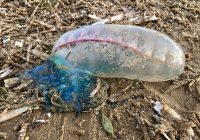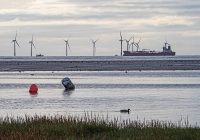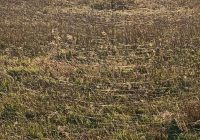Dr Phil Smith’s Wildlife Notes
November 2021
Rainfall in November was about average, with measureable precipitation on 12 days. As a result, the sand-dune water-table rose by a modest 7 cm. It was relatively mild, the first obvious frost being on 22nd. The major weather event of the month was storm Arwen on 26th/27th. This was a deep low-pressure system that tracked down the North Sea, producing northerly winds of up to 98 mph in the Northeast and a ‘Red Weather Warning’. We had an ‘Amber Warning’ and overnight winds as strong as I can remember in 50 years or more. By great good fortune, the storm occurred during neap tides; had there been a spring tide, the infrastructure damage along the coast would have been catastrophic. Although Formby experienced nothing like the damage seen elsewhere, many large conifers came down, blocking the western end of Kirklake Road for several days. Most were Corsican Pines but there was also a Leyland Cypress. I did a quick ring count on two of the pines, which were 50+ and 80+ years old.
November is generally a quiet time for wildlife. However, Ian Wolfenden reported a huge movement of winter thrushes at Hightown on 4th. He estimated an extraordinary number of 5000 Fieldfares and 2000 Redwings flying north. There was no sign of them the following day when I ventured down to the Devil’s Hole at Ravenmeols to measure the water-table. I had to be content with a Buzzard sitting on a Hawthorn bush and a few Common wasps on Ivy at the top of Range Lane.
Strong winds from the southwest on 6-7th brought in an unusual bounty from the tropics, John Dempsey finding a colourful Portuguese-Man-of-War (photo courtesy John Dempsey) and several By-the-wind-sailors on Ainsdale beach. These strange creatures are not jellyfish but a separate group called siphonophores. I have never seen either species, a search of the tide-line a few days later being unsuccessful. Slight compensation was several plants of the regionally notable Lesser Centaury still in flower on the Green Beach.
At Hightown on 10th, it was wonderfully calm with the tide slowly advancing over the sand-flats and the calls of Curlew just audible over the sound of distant surf. There was an eerie light over the sea as ships entering and leaving the Mersey were silhouetted against the wind-turbines. The familiar calls of Pink-footed Geese were heard overhead as skein after skein flow out to roost on the sand-banks.
A walk northwards from Sands Lake at Ainsdale on 22nd was rewarded with two wintering Chiffchaffs calling from Grey Willow bushes. On the beach, there was no sign of the Snow Buntings reported a few days earlier but I logged thee Stonechats, a flock of 20 Linnets and 45 Carrion Crows. Plaintive calls of Grey Plover revealed one or two on the tide edge. A walk back along the Green Beach produced two Cetti’s Warblers singing about 400 m apart. The only insects I saw were small swarms of Winter Gnats, while spiders wove a curtain of gossamer threads across the Newest Green Beach.
The following day I headed to Southport Marine Lake to see if the usual wintering Mediterranean Gull had turned up again. Only Black-headed and Herring Gulls came to my stale biscuits but two of the Black-heads had large leg-rings that I could read from photographs. I haven’t yet heard where they were ringed. Southport beach was unexpectedly enlivened by a flock of 98 Twite. These northern finches are regular winter visitors but often elusive. From photos, I was able to spot one that had colour-rings. Ringing has shown that many of our wintering Twite nest in the Hebrides.
On the final day of the month, I visited Wick’s Lake to photograph a male Mandarin Duck in immaculate plumage that Noel Blundell had found earlier. This exotic duck is becoming more common – even breeding in Lancashire, though I hadn’t seen one on the coast before.
Active management of our duneland nature reserves mostly takes place in the winter. At Cabin Hill National Nature Reserve, I was pleased to see that a large area of grassland had been mowed, helping the Herdwick Sheep keep coarse grasses and Creeping Willow under control. The restoration of the Montagu Road Triangle dune-heath at Freshfield has continued, with more scrub and trees being removed. This is working well, young Heather sprouting from the cleared ground, together with other typical heathland plants, such as Bird’s-foot, Heath Rush and Heath Wood-rush.On the nearby Freshfield Dune Heath Nature Reserve, Andrew Hampson and his volunteers have been cutting large areas of invasive Gorse, revealing a pond I didn’t know existed. Finally, I organised four ‘Buckthorn Bashes’ with up to 14 volunteers on the dunes at Ainsdale, getting rid of Sea Buckthorn which is so damaging to our dune flora.






